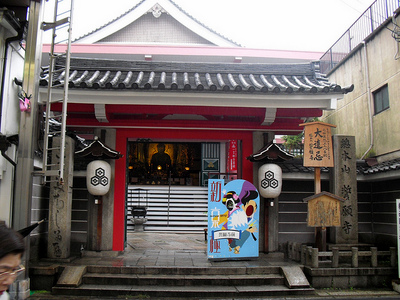Difference between revisions of "Seigan-ji"
From SamuraiWiki
Jump to navigationJump to search (Created page with "*''Japanese'': 誓願寺 ''(seigan ji)'' Seigan-ji is a Buddhist temple in central Kyoto. Located near Rokkaku-Teramachi, the temple is famous for its large Buddha statue and...") |
|||
| (One intermediate revision by the same user not shown) | |||
| Line 1: | Line 1: | ||
| + | [[File:Seiganji.jpg|right|thumb|400px|Seigan-ji]] | ||
*''Japanese'': 誓願寺 ''(seigan ji)'' | *''Japanese'': 誓願寺 ''(seigan ji)'' | ||
| − | Seigan-ji is a Buddhist temple in central Kyoto. Located | + | Seigan-ji is a Buddhist temple in central Kyoto. Located within the Shinkyôgyoku covered shopping arcade district, the temple is famous for its large Buddha statue and fan-mound. The temple features in a [[Noh]] play by [[Seiganji (play)|the same name]]. |
| + | The temple was used in [[1610]] to provide lodgings for King [[Sho Nei|Shô Nei]] of [[Ryukyu Kingdom|Ryûkyû]] and his entourage, when they were on their way from [[Kagoshima]] to [[Sunpu]] and [[Edo]]. | ||
In [[1634]], perhaps because of its proximity to [[Nijo castle|Nijô castle]], the temple was used as lodgings for a group of [[Kingdom of Ryukyu|Ryukyuan]] princes and their entourage, brought by [[Shimazu Iehisa]] to pay respects to [[Tokugawa Iemitsu]] at that time.<ref>Kido Hironari, "Ryukyu shisetsu no seiritsu," ''Shirin'' 99:4 (2016).</ref> | In [[1634]], perhaps because of its proximity to [[Nijo castle|Nijô castle]], the temple was used as lodgings for a group of [[Kingdom of Ryukyu|Ryukyuan]] princes and their entourage, brought by [[Shimazu Iehisa]] to pay respects to [[Tokugawa Iemitsu]] at that time.<ref>Kido Hironari, "Ryukyu shisetsu no seiritsu," ''Shirin'' 99:4 (2016).</ref> | ||
Latest revision as of 10:55, 22 August 2018
- Japanese: 誓願寺 (seigan ji)
Seigan-ji is a Buddhist temple in central Kyoto. Located within the Shinkyôgyoku covered shopping arcade district, the temple is famous for its large Buddha statue and fan-mound. The temple features in a Noh play by the same name.
The temple was used in 1610 to provide lodgings for King Shô Nei of Ryûkyû and his entourage, when they were on their way from Kagoshima to Sunpu and Edo. In 1634, perhaps because of its proximity to Nijô castle, the temple was used as lodgings for a group of Ryukyuan princes and their entourage, brought by Shimazu Iehisa to pay respects to Tokugawa Iemitsu at that time.[1]
References
- ↑ Kido Hironari, "Ryukyu shisetsu no seiritsu," Shirin 99:4 (2016).
